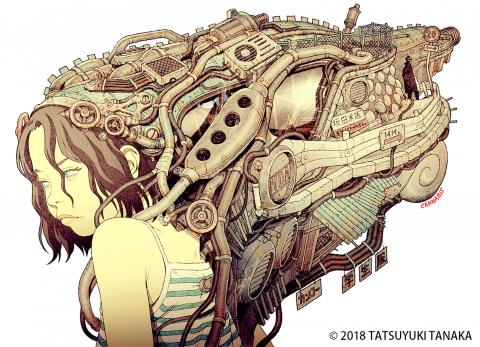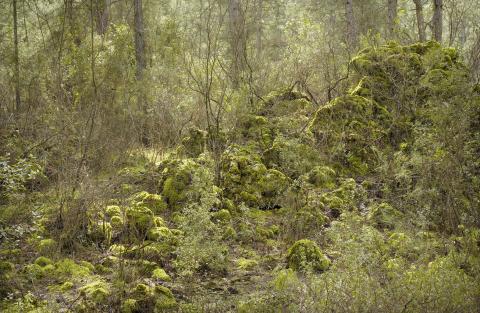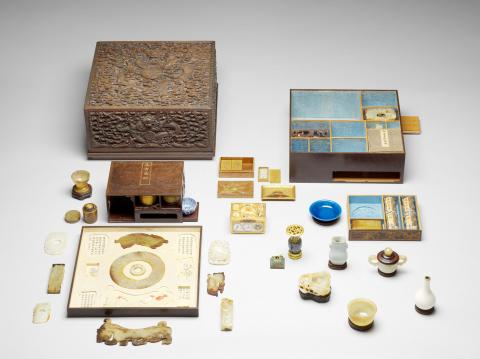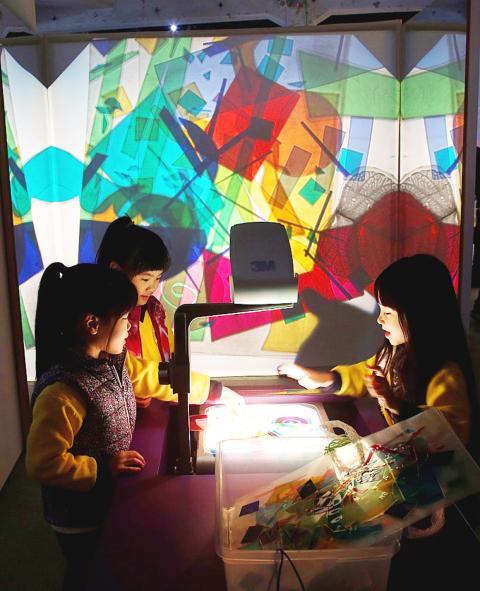This weekend, renown illustrator, animator and comic artist Tatsuyuki Tanaka will be opening an intimate solo exhibition The Phantasmagoric Machines of Tatsuyuki Tanaka (田中達之 — 迷幻的機械) at the animation gallery d/art. Tanaka is known for his animation work in Akira, the legendary 80’s Japanese anime about a post-apocalyptic story in a dystopian, cyberpunk world. Over the years, Tanaka has also worked on a number of other animations, storyboards and art direction projects for leading anime studios such as Gainax Studio and Studio 4C. For his debut exhibition in Taipei, the artist will be presenting 7 original illustrations, some of which are also included in his monographs Cannabis Works and Cannabis Works II. One particular drawing on view was created for the show; it depicts a nonchalant teenage girl wearing a complex industrial engine of metal pipes and ventilation valves that extend from the back of her head to her torso. The machine attaches itself to the girl with multiple suction tubes as if merging machine and body into one co-dependent life. Tanaka’s trademark style features a restrained, somber palette that contrasts with meticulously detailed scenes often depicting machine-inspired creatures and environments. The gallery will tomorrow host a book-signing event, welcoming fans to meet the artist in person. Details can be found on the gallery’s Facebook page (Chinese).
■ d/art Taipei, 2F, 14 Wuchang St, Sec 2, Taipei City (台北市武昌街二段14號2F), tel: (02) 2383-0060. Open Tuesdays to Sundays from 1pm to 10pm
■ Tomorrow until Feb. 14

Photo Courtesy of Taipei d/art and tatsuyuki Tanaka
The National Palace Museum (國立故宮博物院) is holding an exhibition that bridges the gap between contemporary brand design and the museum’s treasured 18th century collection from the Qing Dynasty. Story of a Brand Name — The Collection and Packaging Aesthetics of the Qing Emperor Qianlong features a selection of paintings, calligraphy, rare books and objects from the emperor’s collection that demonstrate his particular way of collecting and handling artworks. The exhibition draws attention to the storage cases in which Qianlong kept his art. The design of these cases “correspond to the modern concepts of product innovations and brand establishment,” writes the museum. In addition to the packaging details, the show also traces how Qianlong developed his distinct collection through a unique sense of taste, connoisseurship and markings of appreciation. The exhibition includes many fine objects, including a sandalwood curio box that stores various porcelains, jades, paintings and other objects in small divided compartments; a Spring and Autumn period bronze bell encased in a pavilion shaped wood stand; and a large jade disk used in rituals to worship the heavens.
■ National Palace Museum (國立故宮博物院), 221, Zhishan Rd, Sec 2, Taipei City (台北市至善路二段221號), tel: (02) 2881-2021. Open Sundays to Thursdays from 8:30am to 6:30pm, Fridays and Saturdays from 8:30am to 9pm
■ Until March 7

Photo Courtesy of the artist
The Stunning Pop-Up Book Exhibition (打開驚奇國際經典立體書展) showcases almost 100 pop-up books in a renovated container gallery in Kaohsiung. The books are targeted towards readers of all ages and cover a variety of themes, including children stories, history, design, art, architecture, animals, film and theater-related books. According to the organizers, Taiwanese are more familiar with regular 2D book designs and have limited access to the culture of pop-up books. This hands-on exhibition allows readers to flip through sample pop-up classics, including Kit Lau’s (劉斯傑) Pop Up Taiwan; Robert Sabuda and Matthew Reinhart’s Encyclopedia Prehistorica Dinosaurs: The Definitive Pop-Up; and Robert Sabuda’s interpretation of Lewis Carroll’s Alice’s Adventures in Wonderland. The exhibition hopes to inspire greater appreciation of sculptural books and their unique promise of surprise and visual pleasure.
■ KUBIC (集合) 5, Fuhsing 3rd Rd, Kaohsiung City (高雄市復興三路5號), tel: (07) 334-7310. Opens Daily from 10am to 6pm, Saturdays to Sundays from 10am to 7pm
■ Until Jan 22

Photo Courtesy of National Palace Museum
Andreas Walther is a German photographer who has had an ongoing rapport with the Taiwan art scene since 2001. His works express patient appreciation of the ephemeral and ambiguous, and in his solo show Atmosphere #2 at Gallery 101, Walther shows 13 works that continue his ongoing interest in the concept of atmosphere. The artist takes this concept from the tradition of shanshui painting (山水畫), an art that includes “giving space to all that is open and nameless,” he says. Walther is drawn to the potential of undecided states, in which there is freedom for things to unfold. The photographs in this show are taken in the wilderness of Taiwan and several European countries; his objective, however, is not to record specific locations or scenery, but rather the abstract senses of visual impressions, sounds, odors, temperature and light variations that work beyond concrete form and language. Untitled #5 is a subtly lit forest scene of mossy rock formations accented with shoots of leafless branches. The subtle temperature of sunlight, the visual density of vegetation and the suggested movement between various compositional elements create a clear sense of sensual flow that hovers beyond the pictorial plane.
■ Gallery 101 (101藝廊) 7, Xinyi Road, Sec 5, Taipei City, (台北市信義區信義路五段7號), tel: (02) 8101-8800. Open Mondays to Fridays from 8am to 6pm
■ Opens on Thursday; until Feb. 23

Photo Courtesy of udnFunLife
The prominent Parisian art museum Centre Georges Pompidou has arrived in Taiwan with a fun-filled children’s workshop and interactive exhibition inspired by iconic European artists including Piet Mondrian, Erro and the 19th century school of French Impressionism. Center Pompidou Kids Atelier: Playing with the Images has four scheduled times per day for workshops that require pre-registration and parent supervision of kids from 5 to 12 years old. These workshops are aimed at exploring the creative power of play and cultivating a sense of aesthetics and understanding of art. One workshop exercise focuses on the concept of light and shadow by overlaying different materials on overhead light projectors. A program of animated art films is also screened alongside the play area for further creative reference. In another part of the exhibition, children assemble abstract city plans with blue, red and yellow rectangles in homage to Mondrian’s signature paintings of geometrical compositions.
■ Huashan 1914 Creative Park (華山1914文創園區東2館AB倉), 1, Bade Rd Sec 1, Taipei City (台北市八德路一段1號), tel: (02) 7737-3988. For schedule times, visit: www.huashan1914.com (Chinese only)
■ Until Feb. 28

In the next few months tough decisions will need to be made by the Taiwan People’s Party (TPP) and their pan-blue allies in the Chinese Nationalist Party (KMT). It will reveal just how real their alliance is with actual power at stake. Party founder Ko Wen-je (柯文哲) faced these tough questions, which we explored in part one of this series, “Ko Wen-je, the KMT’s prickly ally,” (Aug. 16, page 12). Ko was open to cooperation, but on his terms. He openly fretted about being “swallowed up” by the KMT, and was keenly aware of the experience of the People’s First Party

Aug. 25 to Aug. 31 Although Mr. Lin (林) had been married to his Japanese wife for a decade, their union was never legally recognized — and even their daughter was officially deemed illegitimate. During the first half of Japanese rule in Taiwan, only marriages between Japanese men and Taiwanese women were valid, unless the Taiwanese husband formally joined a Japanese household. In 1920, Lin took his frustrations directly to the Ministry of Home Affairs: “Since Japan took possession of Taiwan, we have obeyed the government’s directives and committed ourselves to breaking old Qing-era customs. Yet ... our marriages remain unrecognized,

Not long into Mistress Dispeller, a quietly jaw-dropping new documentary from director Elizabeth Lo, the film’s eponymous character lays out her thesis for ridding marriages of troublesome extra lovers. “When someone becomes a mistress,” she says, “it’s because they feel they don’t deserve complete love. She’s the one who needs our help the most.” Wang Zhenxi, a mistress dispeller based in north-central China’s Henan province, is one of a growing number of self-styled professionals who earn a living by intervening in people’s marriages — to “dispel” them of intruders. “I was looking for a love story set in China,” says Lo,

During the Metal Ages, prior to the arrival of the Dutch and Chinese, a great shift took place in indigenous material culture. Glass and agate beads, introduced after 400BC, completely replaced Taiwanese nephrite (jade) as the ornamental materials of choice, anthropologist Liu Jiun-Yu (劉俊昱) of the University of Washington wrote in a 2023 article. He added of the island’s modern indigenous peoples: “They are the descendants of prehistoric Formosans but have no nephrite-using cultures.” Moderns squint at that dynamic era of trade and cultural change through the mutually supporting lenses of later settler-colonialism and imperial power, which treated the indigenous as